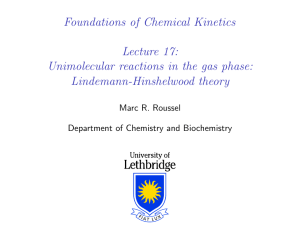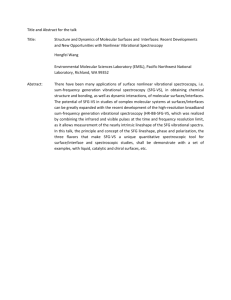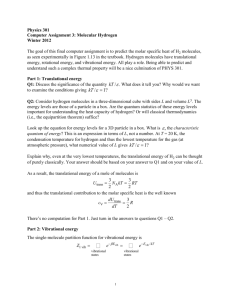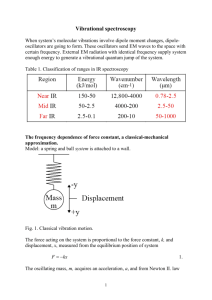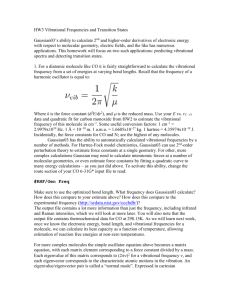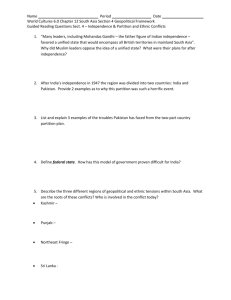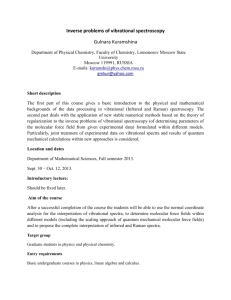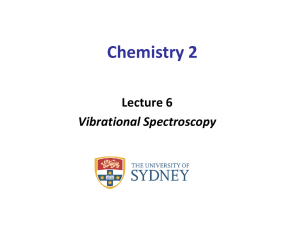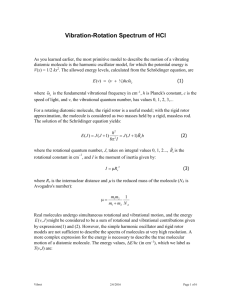kin20917-sup-0001-SuppMat
advertisement
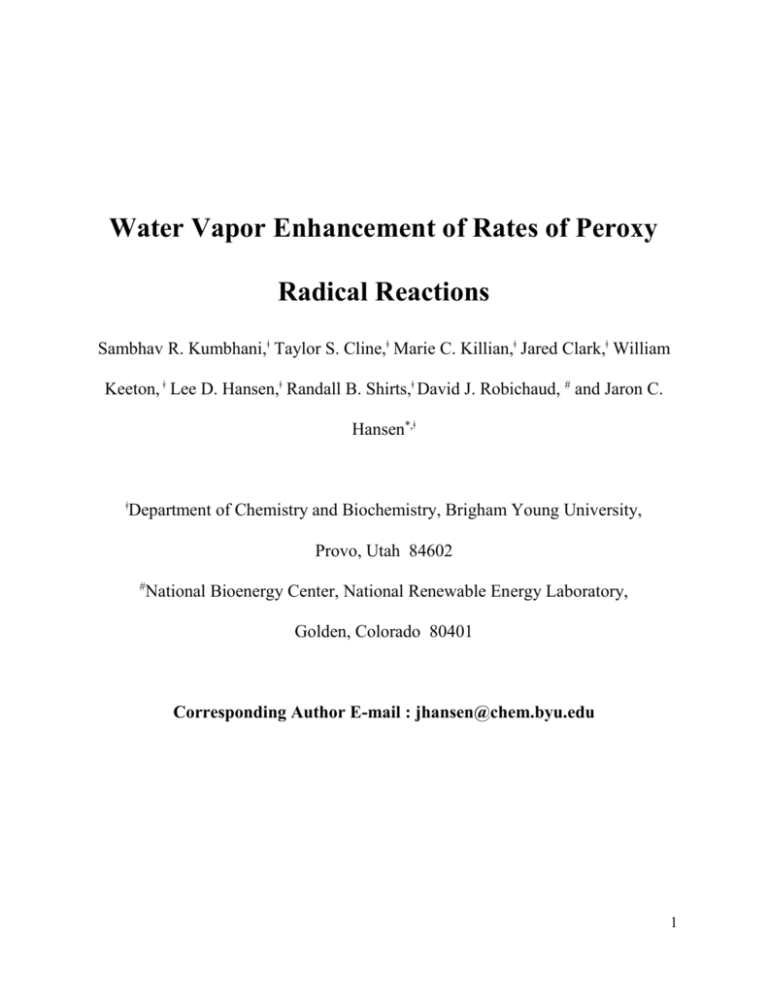
Water Vapor Enhancement of Rates of Peroxy
Radical Reactions
Sambhav R. Kumbhani,ǂ Taylor S. Cline,ǂ Marie C. Killian,ǂ Jared Clark,ǂ William
Keeton, ǂ Lee D. Hansen,ǂ Randall B. Shirts,ǂ David J. Robichaud, # and Jaron C.
Hansen*,ǂ
ǂ
Department of Chemistry and Biochemistry, Brigham Young University,
Provo, Utah 84602
#
National Bioenergy Center, National Renewable Energy Laboratory,
Golden, Colorado 80401
Corresponding Author E-mail : jhansen@chem.byu.edu
1
Supplemental Material
S-1 Computational Methods
S.1.1 Partition function calculations
From the Gaussian 03 calculations, the partition function of each conformation of each
molecule was calculated according to the theory by McQuarrie and Simon.43 The overall
partition function for a molecule is approximated by the product of its translational, rotational,
electronic, and vibrational partition functions, which are assumed to be separable. The
expressions for the translational, rotational, and electronic partition functions are:
V 2mkT
h3
3/2
qT =
(S1)
where V is the volume of the reaction cell, m is the mass of the molecule, k is Boltzmann's
constant, h is Planck's constant, and T is temperature;
kT
q =
hc ABC
3/2
1/2
R
(S2)
where c is the speed of light and A, B, and C are the rotational constants of the molecule;
q E = ge E/(RT )
(S3)
where g is the degeneracy of the electronic ground state and E is the zero-point energy of the
ground vibrational state. Note that the energy in the partition function for all molecules and
geometries must be in reference to the same reference energy.
S.1.2 Vibrational partition function
The vibrational partition function for a molecule is the product of the partition functions
for each of its vibrational modes, assuming that the normal vibrational modes of the molecule are
independent. The partition function of a vibrational mode can be calculated as the sum of the
contributions from each vibrational state,
E
(S4)
qV = e v
v
where = (kT)-1. The energies of the vibrational states can be calculated according to several
models for the vibrational motions. In this calculation, the harmonic oscillator, Morse oscillator,
and hindered rotor models were used for each mode according to the model that best
approximated the vibrational motion of the mode.
2
S.1.3 Harmonic oscillator
A harmonic approximation assumes that the energy levels of a vibrational mode are
equally spaced. This approximation is accurate for the lowest vibrational states and therefore can
be made when only the ground and first excited states are occupied. For a harmonic oscillator,
equation S4 becomes
qV = e vhc =
~
v
1
~
1 e hc
(S5)
where ~ is the fundamental frequency of the vibrational mode. In this calculation, the
fundamental anharmonic frequency calculated in Gaussian was used for ~ .
S.1.4 Morse oscillator
A Morse oscillator can be used to model vibrational modes that are dissociative. A
harmonic oscillator model assumes that all vibrational states are equally spaced and does not
account for the possibility that a bond can dissociate with sufficient energy. Therefore, the
partition function based on the harmonic oscillator tends to underestimate the true partition
function of the mode. The Morse oscillator accounts for the decreasing spacing between the
vibrationally excited states and eventually the dissociation of the bond.
The energy levels for the Morse oscillator potential are given by,
1
1
G (v) = e v xe v
2
2
2
(S6)
where e is the fundamental harmonic vibrational frequency, v is the vibrational quantum
number, and xe is the diagonal element of the X-matrix corresponding to the vibrational mode. If
xe is negative, the bond will eventually dissociate, whereas if xe is positive there are infinitely
many bound states. The bond will dissociate when G(v) achieves a maximum, or at
v* =
e 1
. Therefore, at the highest energy bound state, vmax = v* and there are N = vmax
2 xe 2
+1 bound states. For some states, if the vibration primarily involved the stretching of a hydrogen
bond,
~x was calculated from the dissociation energy for the breaking of the hydrogen bond, D,
e
~x = e
e
4D
2
(S7)
N was then calculated as ~e and rounded to the nearest integer. The partition function was
2x
e
then calculated,
3
V
vmax
e
q =
hc ( G ( v ) G (0)/(kT )
(S8)
v=0
from
~x to calculate G(v) and G(0).
e
S.1.5 Hindered rotor
A hindered rotor model was used to model vibrations that involve the rotation of a
functional group on the molecule. The calculation of the partition function for a hindered rotor
vibration was based on McClurg et al.42
r r/(2 ) r
qV = qHO
I0
e
2
1/2
(S9)
where qHO is the partition function calculated as a harmonic oscillator using the fundamental
harmonic frequency , and r and are defined as
r=
=
2 Iw
kT
2I
w
(S10)
(S11)
where w is the barrier height for the hindered rotor (for this complex, the strength of one or two
hydrogen bonds), and I is the moment of inertia for the rotation.
S.1.6 Local minima weighting
Three local minimum geometries for the complex and two local minimum geometries for
-HEP are all accessible at room temperature. Therefore the partition function for each of these
geometries contributes to the overall equilibrium constant for complex formation. The partition
function for a molecule is
q = e
Ei /( kT )
(S12)
i
where i denotes all of the states for the molecule. Therefore the partition functions for -HEPH2O and -HEP are equal to the sums of the partition functions for each of the local minimum
geometries if they have a common reference energy. Therefore, the equilibrium constant for the
complex formation is equal to
4
q[ HEP H 2O ] q[ HEP H 2O ] q[ HEP H 2O ]
1
2
3
V
Ke =
(
q[ HEP] q[ HEP]
1
V
2
)(
q[ H 2 O ]
V
(S13)
)
5
Figure S 1 Potential energy surface for Cl + HOCH2CH2Cl reaction
Figure S-1: Potential energy surface diagram for the reaction of Cl + HOCH2CH2Cl calculated at
MP2/6-311++G(3df,3pd). Energies reported in kcal mol-1. The energies of both reactants (Cl and
HOCH2CH2Cl), pre-reactive complex and transition states were optimized using the B3LYP/6311++G(3df,3pd) method/basis set. Single point calculations were computed at the MP2/6311++G(3df,3pd) level for all species using the optimized geometry computed at the B3LYP/6311++G(3df,3pd) level.
.
6
S-2 Calculation of concentrations of O3, HO2, β-HEP and βHEP-H2O from measured absorbances
From the Beer-Lambert Law, where b is pathlength, σ is absorption cross section, and [ ]
indicates concentrations
𝑂
𝐴220 = 𝑏 (
𝛽−𝐻𝐸𝑃
𝐻𝑂
3
𝜎220
[𝑂3 ] + 𝜎2202 [𝐻𝑂2 ] + 𝜎220
𝛽−𝐻𝐸𝑃−𝐻2 𝑂
𝜎220
[𝛽
[𝛽 − 𝐻𝐸𝑃] +
− 𝐻𝐸𝑃 − 𝐻2 𝑂]
)
(S14)
𝑂
𝐴230 = 𝑏 (
𝛽−𝐻𝐸𝑃
𝐻𝑂
3
𝜎230
[𝑂3 ] + 𝜎2302 [𝐻𝑂2 ] + 𝜎230
𝛽−𝐻𝐸𝑃−𝐻2 𝑂
𝜎230
[𝛽
[𝛽 − 𝐻𝐸𝑃] +
− 𝐻𝐸𝑃 − 𝐻2 𝑂]
)
(S15)
𝑂
𝐴254 = 𝑏 (
𝛽−𝐻𝐸𝑃
𝐻𝑂
3
𝜎254
[𝑂3 ] + 𝜎2542 [𝐻𝑂2 ] + 𝜎254
𝛽−𝐻𝐸𝑃−𝐻2 𝑂
𝜎254
[𝛽 − 𝐻𝐸𝑃] +
[𝛽 − 𝐻𝐸𝑃 − 𝐻2 𝑂]
)
(S16)
Since the cross sections of the β-HEP-H2O complex is unknown, we assume
𝛽−𝐻𝐸𝑃−𝐻2 𝑂
𝜎𝑥
𝛽−𝐻𝐸𝑃
= 𝑓𝑥 𝜎𝑥
(S17)
Where 𝑓𝑥 ≥ 0 and 𝑥 = 200 − 400 nm.
Substituting Equation S17 into the last two terms of equation S14,15 and 16 yields,
𝛽−𝐻𝐸𝑃
𝜎𝑥
[𝛽 − 𝐻𝐸𝑃] +
𝛽−𝐻𝐸𝑃−𝐻2 𝑂
𝜎𝑥
[𝛽
− 𝐻𝐸𝑃 − 𝐻2 𝑂]
𝛽−𝐻𝐸𝑃
= 𝜎𝑥
𝛽−𝐻𝐸𝑃
[𝛽 − 𝐻𝐸𝑃] + 𝑓𝑥 𝜎𝑥
[𝛽 − 𝐻𝐸𝑃 − 𝐻2 𝑂]
(S18)
The equilibrium constant for the formation of the β-HEP-H2O complex is,
𝐾 =
Solving for β-HEP-H2O gives,
[𝛽 − 𝐻𝐸𝑃 − 𝐻2 𝑂]
[𝛽 − 𝐻𝐸𝑃][𝐻2 𝑂]
[𝛽 − 𝐻𝐸𝑃 − 𝐻2 𝑂] = 𝐾[𝛽 − 𝐻𝐸𝑃][𝐻2 𝑂]
(S19)
Substituting Equation S19 into S18 yields,
7
𝛽−𝐻𝐸𝑃
𝜎𝑥
[𝛽 − 𝐻𝐸𝑃] +
𝛽−𝐻𝐸𝑃−𝐻2 𝑂
𝜎𝑥
[𝛽
𝛽−𝐻𝐸𝑃
− 𝐻𝐸𝑃 − 𝐻2 𝑂]
= 𝜎𝑥
𝛽−𝐻𝐸𝑃
[𝛽 − 𝐻𝐸𝑃] + 𝑓𝑥 𝐾𝜎𝑥
[𝛽 − 𝐻𝐸𝑃][𝐻2 𝑂]
(S20)
Factoring out
𝛽−𝐻𝐸𝑃
𝜎𝑥
[𝛽
𝛽−𝐻𝐸𝑃
𝜎𝑥
− 𝐻𝐸𝑃] yields Equation S21
[𝛽 − 𝐻𝐸𝑃] +
𝛽−𝐻𝐸𝑃−𝐻2 𝑂
𝜎𝑥
[𝛽
− 𝐻𝐸𝑃 − 𝐻2 𝑂]
𝛽−𝐻𝐸𝑃
= 𝜎𝑥
[𝛽 − 𝐻𝐸𝑃][1 + 𝑓𝑥 𝐾[𝐻2 𝑂]]
(S21)
Thus the equations for absorbance at 220, 230 and 254 reduce to,
𝑂3
𝛽−𝐻𝐸𝑃
𝐻𝑂
𝐴220 = 𝑏(𝜎220
[𝑂3 ] + 𝜎2202 [𝐻𝑂2 ] + 𝜎220 [𝛽 − 𝐻𝐸𝑃]{1 + 𝑓230 𝐾[𝐻2 𝑂]})
(S22)
𝑂3
𝛽−𝐻𝐸𝑃
𝐻𝑂
𝐴230 = 𝑏(𝜎220
[𝑂3 ] + 𝜎2202 [𝐻𝑂2 ] + 𝜎220 [𝛽 − 𝐻𝐸𝑃]{1 + 𝑓230 𝐾[𝐻2 𝑂]})
(S23)
𝑂3
𝛽−𝐻𝐸𝑃
𝐻𝑂
𝐴254 = 𝑏(𝜎220
[𝑂3 ] + 𝜎2202 [𝐻𝑂2 ] + 𝜎220 [𝛽 − 𝐻𝐸𝑃]{1 + 𝑓254 𝐾[𝐻2 𝑂]})
(S24)
If, 0 ≤ 𝑓220 , 𝑓230 , 𝑓254 ≤ 10, the product of 𝑓220 𝐾[𝐻2 𝑂], 𝑓230 𝐾[𝐻2 𝑂], 𝑓254 𝐾[𝐻2 𝑂] ≈ 0. Thus the
observed β-HEP concentration in this experiment is,
[𝛽 − 𝐻𝐸𝑃]𝑜𝑏𝑠𝑒𝑟𝑣𝑒𝑑 = [𝛽 − 𝐻𝐸𝑃][1 + 𝑓𝑥 𝐾[𝐻2 𝑂]] ≈ [𝛽 − 𝐻𝐸𝑃]
(S25)
If 𝑓𝑥 =0, the two cross sections do not overlap and the observed signal in this experiment is only
due to β-HEP. If 𝑓𝑥 > 0 there is an overlap between the two cross sections and the observed
signal in this experiment is due to both β-HEP and β-HEP-H2O complex. In either case, the
equations to solve for the concentrations of ozone, β-HEP and HO2 reduce to
𝑂
𝐻𝑂
𝛽−𝐻𝐸𝑃
3
𝐴220 = 𝑏(𝜎220
[𝑂3 ] + 𝜎2202 [𝐻𝑂2 ] + 𝜎220
[𝛽 − 𝐻𝐸𝑃])
(S26)
𝑂3
𝛽−𝐻𝐸𝑃
𝐻𝑂
𝐴230 = 𝑏(𝜎230
[𝑂3 ] + 𝜎2302 [𝐻𝑂2 ] + 𝜎230 [𝛽 − 𝐻𝐸𝑃])
(S27)
𝑂3
𝛽−𝐻𝐸𝑃
𝐻𝑂
𝐴254 = 𝑏(𝜎254
[𝑂3 ] + 𝜎2542 [𝐻𝑂2 ] + 𝜎254 [𝛽 − 𝐻𝐸𝑃])
(S28)
8
The HO2 concentration calculated by solving equation S26, 27, 28 was always below our
detection limit of 1×1013 molecules/cm3. Thus the general form of the measured absorbance is
given by Equation 1 in the paper
𝑂
𝛽−𝐻𝐸𝑃
𝐴𝑥 = 𝑏 (𝜎𝑥 3 [𝑂3] + 𝜎𝑥
[𝛽 − 𝐻𝐸𝑃])
Equation 1
S-3 Kinetic Equations
To derive Equation 2, we define the following variables
Concentration of un-complexed [β-HEP] = [𝑢]
Concentration of complexed β-HEP [β-HEP-H2O] = [𝑐]
Concentration of observed β-HEP = [𝑜]
Concentration of water = [𝑤]
Observed rate constant = 𝑘𝑜
From elementary reactions 3 and 5, the rate of loss of un-complexed β-HEP is given by
𝑑[𝑢]
= −2𝑘3 [𝑢]2 − 𝑘5 [𝑢][𝑐]
𝑑𝑡
(S29)
From elementary reactions 5 and 6, the rate of loss of β-HEP-H2O is given by
𝑑[𝑐]
= −𝑘5 [𝑢][𝑐] − 2𝑘6 [𝑐]2
𝑑𝑡
(S30)
To obtain k3,k5 and k6 as functions of ko we introduce the relationship,
𝑑[𝑜]
= −2𝑘𝑜 [𝑜]2
𝑑𝑡
(S31)
Substituting equation S25 (the observed concentration of β-HEP in our experiment) in equation
S31 yields,
𝑑[𝑜]
= −2𝑘𝑜 ([𝑢][1 + 𝑓𝐾[𝑤])2
𝑑𝑡
= −2𝑘𝑜 [𝑢]2 ([1 + 𝑓𝐾[𝑤])2
(S32)
Adding Equations S-29 and S-30 gives the theoretically observed loss of β-HEP in this
experiment
𝑑[𝑜]
𝑑[𝑢] 𝑑[𝑐]
=
+
= −2𝑘3 [𝑢]2 − 2𝑘5 [𝑢][𝑐] − 2𝑘6 [𝑐]2
𝑑𝑡
𝑑𝑡
𝑑𝑡
9
(S33)
Equating S-32 and S-33 gives,
−2𝑘𝑜 [𝑢]2 ([1 + 𝑓𝐾[𝑤])2 = −2𝑘3 [𝑢]2 − 2𝑘5 [𝑢][𝑐] − 2𝑘6 [𝑐]2
(S34)
The equilibrium constant for complex formation is given by
[𝑐]
𝐾=
[𝑢][𝑤]
[𝑐] = 𝐾[𝑢][𝑤]
Thus,
(S35)
Substituting Equation S-35 into Equation S34 gives,
−2𝑘𝑜 [𝑢]2 ([1 + 𝑓𝐾[𝑤])2 = −2𝑘3 [𝑢]2 − 2𝑘5 [𝑢]2 𝐾[𝑤] − 2𝑘6 [𝑢]2 [𝑤]2 𝐾 2
(S36)
Dividing Equation S36 by -2[𝑢]2 on both sides yields,
𝑘𝑜 ([1 + 𝑓𝐾[𝑤])2 = 𝑘3 + 𝑘5 [𝑢]𝐾[𝑤] + 𝑘6 [𝑢]2 [𝑤]2 𝐾 2
Solving for ko gives,
𝑘𝑜 =
𝑘3 + 𝑘5 [𝑢]𝐾[𝑤] + 𝑘6 [𝑢]2 [𝑤]2 𝐾 2
([1 + 𝑓𝐾[𝑤])2
(S37)
From calculated values of the equilibrium constant (Figure 8) and the slopes of the experimental
data (Figure 7), 𝑘6 [𝑢]2 [𝑤]2 𝐾 2 << 𝑘3 + 𝑘5 [𝑢]𝐾[𝑤]. Further within the uncertainty, there is no
evidence for curvature in data in Figure 7.
Also, if 𝑓 = 1 the cross section of β-HEP and the complex are equal then 1 + 𝑓𝐾[𝑤] ≈ 1. If 𝑓 =
0 the cross section of β-HEP and the complex are distinguishable, then 1 + 𝑓𝐾[𝑤] = 1. In either
case Equation S -37 reduces to Equation 2 in the manuscript as,
𝑘𝑜 = 𝑘3 + 𝑘5 𝐾[𝑤]
Equation 2
S-4 Derivation of Equation 3
Following is the derivation of equation of Equation 3 from Equation 2
𝑘𝑜 = 𝑘3 {1 +
𝑘5
𝐾 [𝑤]}
𝑘3
(S38)
From the Arrhenius expression for the temperature dependence of the rate coefficients and van’t
10
Hoff equation for the temperature dependence of the equilibrium constant,
−𝐸3
𝑘3 = 𝐴3 𝑒 ( 𝑅𝑇 )
(S39a)
−𝐸5
𝑘5 = 𝐴5 𝑒 ( 𝑅𝑇 )
(S39b)
−∆𝐻
𝐾 = 𝐶 ∗ 𝑒 ( 𝑅𝑇
)
(S39c)
Substituting S-39a, S39b, S39c into Equation S-38 gives,
−𝐸5
𝑘𝑜 = 𝑘3 {1 +
𝐴5 𝑒 ( 𝑅𝑇 )
−𝐸3
−∆𝐻
𝐶𝑒 ( 𝑅𝑇 ) [𝑤]}
𝐴3 𝑒 ( 𝑅𝑇 )
𝐴5 ∗ 𝐶 (−(∆𝐻+𝐸5 −𝐸3 )
𝑅𝑇
𝑘𝑜 = 𝑘3 {1 +
𝑒
[𝑤]}
𝐴3
(S40)
Combining parameters, A5C/A3 = A and (E5+∆H-E3)= E reduces Equation S40 to Equation 3 in
the manuscript.
−𝐸
𝑘𝑜 = 𝑘3 {1 + 𝐴𝑒 ( 𝑅𝑇 ) [𝑤]}
Equation 3
11

